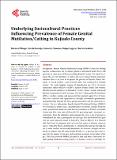| dc.contributor.author | Mbogo, Bernard | |
| dc.contributor.author | Karanja, Sarah | |
| dc.contributor.author | Omwaka, Kennedy | |
| dc.contributor.author | Lugayo, Denge | |
| dc.contributor.author | Leshore, Charles | |
| dc.date.accessioned | 2021-08-19T08:46:07Z | |
| dc.date.available | 2021-08-19T08:46:07Z | |
| dc.date.issued | 4/25/2019 | |
| dc.identifier.citation | Mbogo, B., Karanja, S., Omwaka, K., Lugayo, D. and Leshore, C. (2019) Underlying Sociocultural Practices Influencing Prevalence of Female Genital Mutilation/Cutting in Kajiado County. Advances in Sexual Medicine, 9, 17-28 | en_US |
| dc.identifier.issn | 2164-5205 | |
| dc.identifier.uri | http://dspace.amref.org/handle/123456789/96 | |
| dc.description | This work is licensed under the Creative Commons Attribution International License (CC BY 4.0).
http://creativecommons.org/licenses/by/4.0/ | en_US |
| dc.description.abstract | Background: Female Genital Mutilation/Cutting (FGM/C) often has lifelong negative consequences for a woman’s physical and mental health but is still practiced in some parts of Kenya including Kajiado County. We aimed to estimate the current prevalence as well as the socio-cultural beliefs and power relations that are in favor of or against the practice in Kajiado, Kenya. Methods: A mixed method cross-sectional study was conducted in Kajiado County. The study targeted: women of reproductive age (15 to 49 years); community health volunteers (CHVs); opinion leaders; health care workers; officials from the ministries of Education, Health, Culture, Gender and Social Services; Community Health Assistants (CHAs); Traditional Birth Attendants (TBAs); teachers; morans and adolescent boys and girls aged 10 to 24 years. Data were collected both quantitatively through a household questionnaire and qualitatively through the focus group discussions and key informant interviews. Factors influencing Female Genital Mutilation/Cutting (FGM/C) were classified as either social, cultural beliefs or economic. Results: From the study, quantitative results revealed that the prevalence of FGM/C in Kajiado County was 91%, with most of them (96.7%) practicing type 2 (excision) circumcisions. From the interviews, girls undergo the cut as a rite of passage to womanhood and thus a prerequisite for marriage. It is also believed that girls who are uncircumcised cannot be helped by TBAs in delivery. It is believed that their blood is poisonous and can cause bad omen to whoever comes in contact with dirty blood. Additionally, it is believed that girls go through the cut to avoid conflict and natural phenomena; for instance, drought and outbreaks of diseases that kill many people. Finally, it is a practice that earns respect for the parents of the girls and incentives as dowry to the father of the girl. TBAs that perform FGM/C get paid in cash and kind. Conclusion: Female genital mutilation/cutting practice in Kajiado County is still high. Efforts to end the practice will need to have an integrated approach to include all the players. Suggested alternatives to the cut must, therefore, be inclusive so as to address the myths/beliefs, misconceptions, socio-cultural and economic factors in favor of the vice. The alternatives must be inclusive for the beneficiaries, supporters, and practitioners. | en_US |
| dc.language.iso | en | en_US |
| dc.publisher | Scientific Research Publishing Inc | en_US |
| dc.subject | Female Genital Mutilation | en_US |
| dc.subject | Alternative Rite of Passage | en_US |
| dc.subject | Prevalence | en_US |
| dc.subject | Kajiado County | en_US |
| dc.subject | Kenya | en_US |
| dc.title | Underlying Sociocultural Practices Influencing Prevalence of Female Genital Mutilation/Cutting in Kajiado District | en_US |
| dc.type | Article, Journal | en_US |

